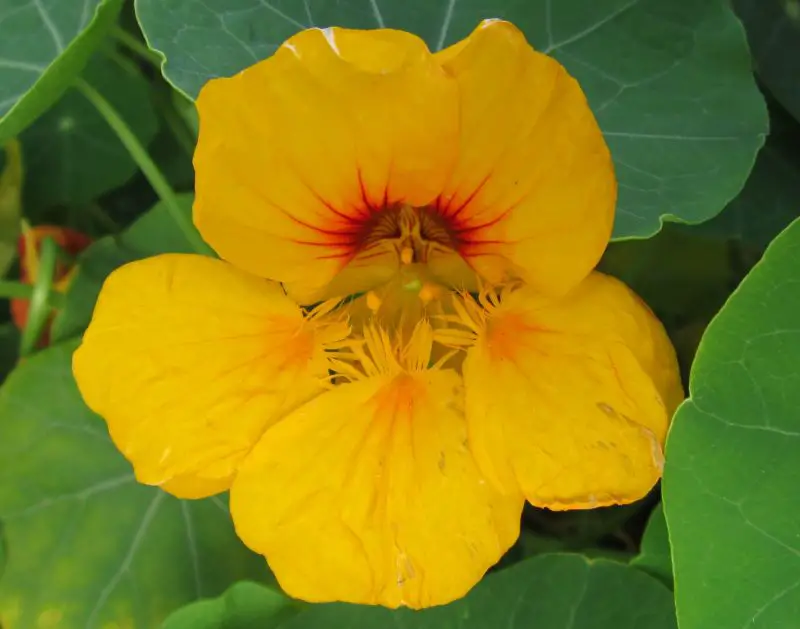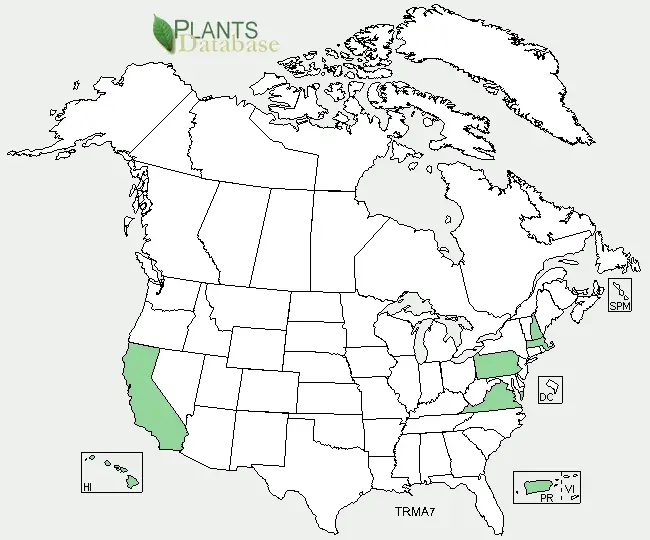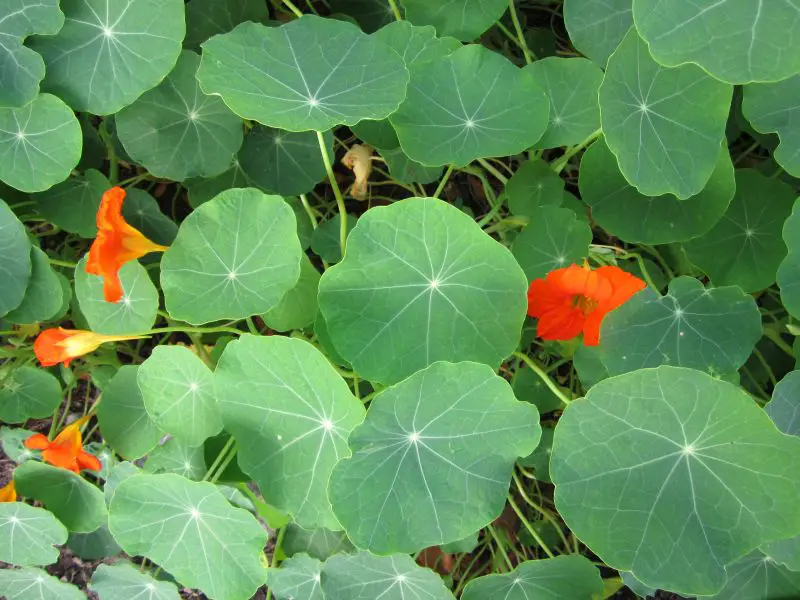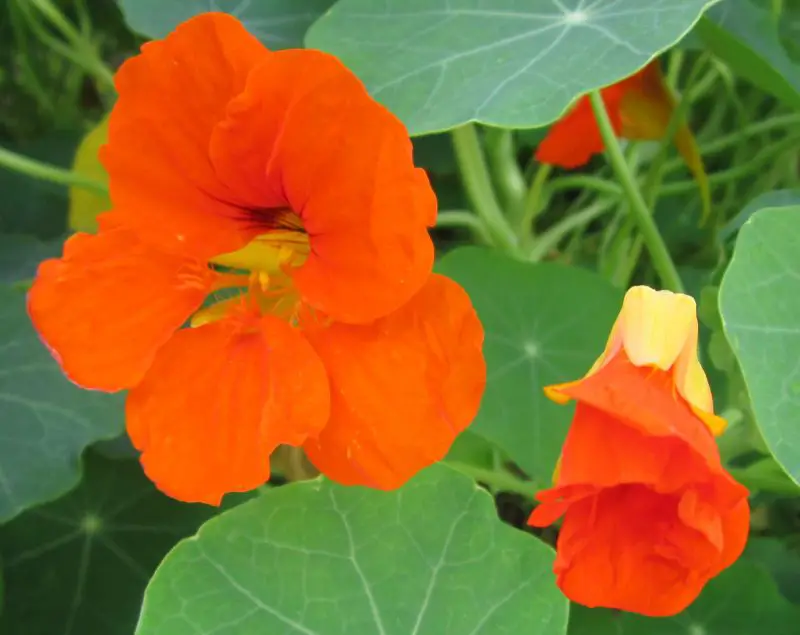
Search Wild Foods Home Garden & Nature's Restaurant Websites:
Nasturtium (Garden)

(NOTE: If you are not interested in growing Nasturtium, but just finding the plant and using it, try going to the Nature's Restaurant Online site for Nasturtium Leaves and Nasturtium Flowers.)
Garden Nasturtium: (Tropaeolum majus). Sometimes also called the Indian Cress or Monks Cress. This is the plant you see in gardens with the lily pad shaped leaves and the yellow, orange or red flowers. This is not a plant that is native to Eastern North America, but it is planted as an ornamental all over, and is a good plant to put in a vegetable garden with any plant from the Cabbage family (Brassicaceae) and Pumpkins, Squash and Zucchini (the Cucurbita family) as it deters pests that are a problem for both. Hard to claim this is a wild plant, but it has naturalized in areas of Eastern North America having escaped gardens. And, Dandelions are not native either, but people think they are a wild plant. So on that logic, I'm going to include them. Besides, they are a good, edible green and flower, and make a good companion plant.
This plant has three unusual features. One, a drop of water on the leaf will form a flat bottomed sphere. Two, In the evening, look at the flower of an orange one, and you may see flashes of light. This is called the "Elizabeth Linnæus Phenomenon". Third, the stems are sensitive to touch, and will bend toward what touches them, or what they touch. They use this to wrap around other materials to get height.
Is the growing of this plant compatible with Natural farming, Ecoagriculture or Eco friendly agriculture, Ecological farming, Sustainable agriculture, Agroforestry or Agro-sylviculture and Permaculture: You can use Natural farming, no-till garden methods with this plant, or in tilled gardens. It needs to be replanted each year, but other than an small hole for planting, you don't need to till the soil where it is planted. When used as a companion plant in conventional gardens, planted where the soil is tilled, it works fine.
Seeds: I have to admit, I've never tried getting seed from the plants I've grown, so I can't speak to that. I've always bought seed in the store in the spring. There is a range of colors available.
Soil & Site: This plant wants two things. One, full sun. Two, well drained soil - and it can be poor quality soil, so don't go out of your way to make rich, loamy soil specifically for this one. Prepare the soil first, like most plants, they will do better in soil that is not compacted. You don't have to fertilize them.
Planting: Plant them about 2-2.5 cm (3/4 to 1 inch) deep. I just poke a hole in the soil up to the first joint on my finger, drop in a seed, cover and firm the soil down by pushing lightly with my knuckles. When all are planted, water, and keep soil moist until they are established. Because they are a food plant to me, and keep pests away from plants in the Cabbage and Cucurbita family, I always plant them around those plants in the garden at the same time. I've always planted them about a hand width away from Squash and Zucchini around them to protect them when they are young from pests. The Squash and Zucchini just grow right over them, and as far as I can tell, suffer in no way. Also, in the summer the Nasturtiums keep the soil in the shade helping the soil stay moist and cool, lessening water requirements a little.
Maintenance: There really is nothing to do. I guess you could water them if they started to droop, but since I plant them as a companion plant, the other plants need water long before these do, so they get watered with the others.
Harvesting: Pick younger, smaller leaves as you want them. Pick flowers just before you are going to use them. If you are going to pickle the unripe seed pods for use like capers, you have to keep an eye on them and get them before the seeds start to mature - right after the flower dies.
Using: The leaves of the plant are good in a salad, giving a peppery taste like Watercress. Since you shouldn't eat Watercress raw (it can harbour parasites from animal manure that may find its way into the water it is growing in), this makes a great substitute. The flowers and pickled unripe seed pods are edible. The flowers look great on a salad, and add a peppery taste like the leaves. The flowers are really good dipped in a thin batter and deep fried. The unripe seed pods can be pickled and used like capers. There are three separate recipe links below the description, one for using the leaves, one for using the flowers, and one for pickling the seed pods.
Description:
- USDA Plant Hardiness Zone: 3-10 (More information on hardiness zones).
- Soil pH: 6.0-7.5
- Plant Size: Has trailing stems that can grow to 1.5 meters (5 feet) long. Leaves of plant can be up to 30 cm (12 inches) off the ground
- Duration: Annual
- Leaf Shape: Peltate, circular
- Leaf Phyllotaxis (Arrangement) on branch: Alternate
- Leaf Size: 3-15 cm (1 1/5 to 6 inches) diameter
- Leaf Margin: Entire (smooth) to shallow, rounded lobes
- Flowers: Bright orange, yellow or red. Five petals. 2.5–6 cm (1 to 2 1/3 inches) diameter
- Fruit: Single seeded, 2 cm (3/4 inch) wide, three-segmented fruit.
- Habitat: Originally from the foot-hills of the Andes in Peru, now found in flower gardens all over Eastern North America, and catching on as a companion plant in vegetable gardens.
Web Resources:
- Recipe search on the web for the leaves here (Google search) and here (Bing search).
- Recipe search on the web for the flowers here (Google search) and here (Bing search).
- Recipe search on the web for pickling the seed pods here (Google search) and here (Bing search).
- Pictures on the web here (Google images) and here (Bing images).
- Interactive USDA distribution map and plant profile here.
- The Biota of North America Program (BONAP) distribution map here. BONAP map color key here.

Garden Nasturtium: (Tropaeolum majus) range. Distribution map courtesy of U. S. Department of Agriculture (USDA Natural Resources Service) and used in accordance with their policies.

Garden Nasturtium. The leafs make a great salad green giving a gentle peppery taste with a nice texture. Hard to mistake this plant with anything else. If you want to be absolutely sure, put a couple of drops of water on the leaf. The water will bead into a flat bottomed sphere.

Edible, beautiful & peppery to the taste. There are red flowers as well. They all taste about the same. The flowers are very good dipped in batter and deep fried.
Search Wild Foods Home Garden & Nature's Restaurant Websites:
Share:
Why does this site have ads?
Originally the content in this site was a book that was sold through Amazon worldwide. However, I wanted the information to available to everyone free of charge, so I made this website. The ads on the site help cover the cost of maintaining the site and keeping it available.
Google + profile
